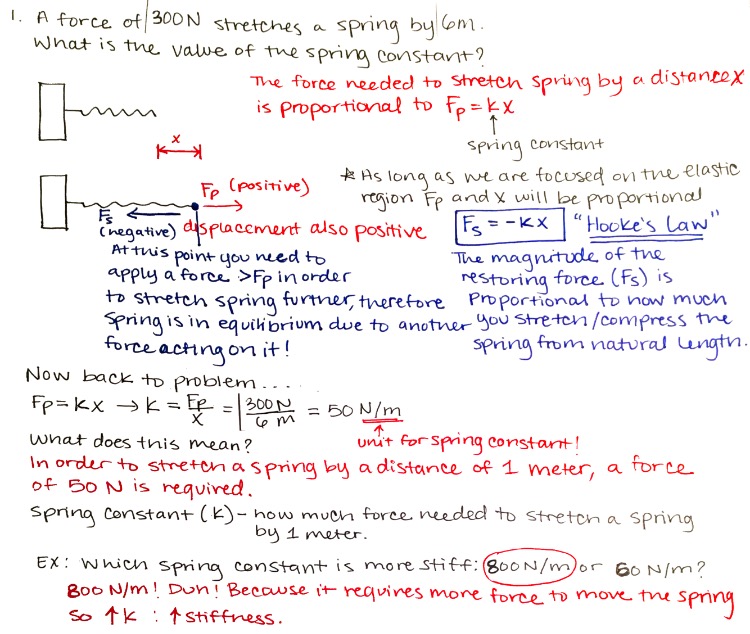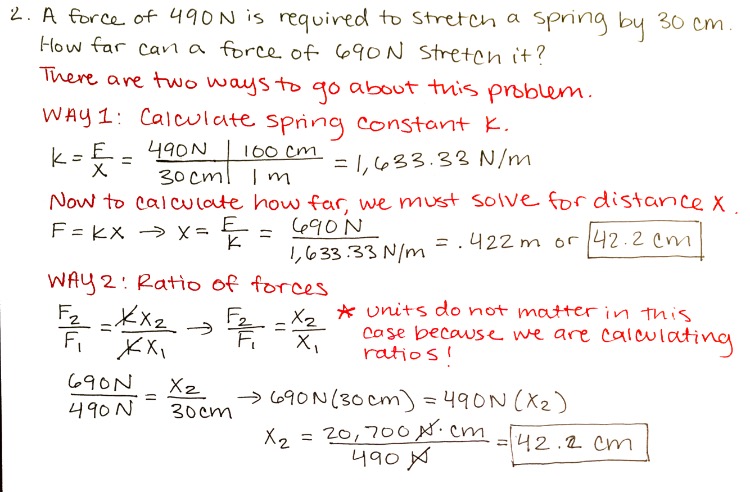Hooke's Law
This resource page addresses Hooke's Law.
Claimed by Navila Akther Spring 2018
The Main Idea
Hooke's law or the law of elasticity named after 17th century Physicist Robert Hooke is the law that states the Force acting on an elastic object is equal to k*x. In other words, the law states that the force required to stretch an elastic object such as a spring is directly proportional to how far the object stretches. The force may be applied to the spring by stretching, compressing, squeezing, bending, or twisting. The value of k depends on the material, its dimensions, and shape. Hooke's law may also be expressed in terms of stress and strain. Stress is the force applied per unit area of a material and strain is the relative change in shape or size due to a force acting on it.
Units of Measurement
The SI units of Force is N (newtons) or kg·m/s2 (kilograms times meters per second squared) and for displacement is m (meters). The SI units for the spring constant k is N/m (newtons per meter) or kg/s2 (kilograms per second squared).
A Mathematical Model
This system can be expressed as F = ks, where k is a constant specific to that material and s is the stretch of the object. In some cases it will be expressed as F=-ks, in this case F is the restoring force that causes elastic materials to return to their original dimensions rather than the applied force.
A Computational Model
A vpython visualization of Hooke's Law
History
Hooke's law is named after the 17th century British physicist Robert Hooke. He first stated the law in 1660 as a Latin anagram then published the solution in 1678 named ut tensio, sic vis which translated means "the extension is proportional to the force." Hooke discovered this law when there was a need to navigate trade routes and avoid dangerous waters effectively. He came up with the idea of using a coiled spring in a watch to tell time. Although he wasn't the first to complete the spring based watch, he is credited with the discovery of the relationship of the spring as it is believed to be his idea first.
Real Life Applications
In addition to springs, Hooke’s Law also applies in many other situations where an elastic body is deformed. Some examples include inflating a balloon and pulling on a rubber band to measuring the amount of wind force is needed to make a tall building bend and sway. This law has had many real life applications, such as the creation of a balance wheel, the mechanical clock, the portable timepiece, the spring scale and the manometer. Also, because it is a close approximation of all solid bodies, it is applicable to numerous branches of science and engineering. These include the disciplines of seismology, molecular mechanics and acoustics.
Problem Set
A few sample problems and their solutions.
Question 1
Question 2
Question 3
When the weight hung on a spring is increased by 60 N, the new stretch is 15 cm more. If the original stretch is 5 cm, what is the original weight?
SOLUTION:
Click Here
See also
Robert Hooke
Spring Potential Energy
Tension
Young's Modulus
Further reading
Encyclopedia Brittanica: Hooke's Law
External links
Doodle Science provides a brief run through of Hooke's Law.
An alternate explanation of Hooke's Law with a sample problem set.
References
[1]
[2]
[3]
Invention by Design: How Engineers Get from Thought to Thing. Cambridge, MA: Harvard University Press

